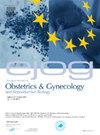一家教学医院 3a 级产科肛门括约肌损伤修复的回顾性分析:主观和客观结果。
IF 1.9
4区 医学
Q2 OBSTETRICS & GYNECOLOGY
European journal of obstetrics, gynecology, and reproductive biology
Pub Date : 2024-10-09
DOI:10.1016/j.ejogrb.2024.10.013
引用次数: 0
摘要
导言:英国皇家妇产科医师学会(RCOG)建议为肛门直肠功能障碍、肛门内超声波检查(EA USS)异常和/或肛门测压(AM)异常的产科肛门括约肌损伤(OASI)患者提供选择性剖腹产(CS)以进行后续分娩。 (1) 然而,由于英国各地的诊断资源有限,无症状的OASI患者,尤其是3a裂伤患者,并不总能接受EA USS或AM检查。本文回顾了 3a 裂口妇女的主观和客观结果,旨在为支持良好实践和管理的文献提供补充:研究设计:我们对2020年1月至2022年12月期间在一家三级转诊会阴诊所接受3a OASI撕裂初次修复的69名女性进行了回顾性研究。使用肛门失禁圣马克评分(SMI)和EA USS缺陷斯塔克评分对症状进行评估。结果使用 R Foundation 统计软件(4.2.2 版,2022 年)进行分析:其中,42%(29/69)的妇女在 EA USS 上有缺陷,30%(21/69)的妇女有症状。38%(18/48)的无症状妇女被发现有缺陷,而有症状的患者中这一比例为 52%(11/21)。大部分缺损位于肛管中上部(69%),表现为 3 hr 低回声区。两组患者的缺损率(X2 = 2.06,P = 0.15)或 Starck 评分(2.23 对 1.53,P = 0.22)无明显差异。然而,使用产钳(p = 0.004)和亚裔(p = 0.01)分娩的患者更容易出现症状:结论:应向所有肛门直肠指诊后的患者提供 USS,因为仅凭症状并不能预测肛门直肠的结构和/或功能是否受损。3a裂伤的无症状患者应被告知,EA USS发现缺陷的几率高达40%。本文章由计算机程序翻译,如有差异,请以英文原文为准。
Retrospective analysis of 3a obstetric anal sphincter injury repairs in a teaching hospital: Subjective and objective outcomes
Introduction
The Royal College of Obstetricians and Gynaecologists (RCOG) recommends offering elective caesarean sections (CS) for subsequent deliveries to obstetric anal sphincter injury (OASI) patients with anorectal dysfunction, or abnormal endoanal ultrasonography (EA USS), and/or anal manometry (AM). (1) Asymptomatic OASI patients however, are not always offered EA USS or AM due to limited access to diagnostic resources across the United Kingdom, particularly those with 3a tears. This paper reviews subjective and objective outcomes in women with 3a tears and aims to add to the body of literature supporting good practice and management.
Objectives
Identify the incidence of defects in patients with 3a tears following a primary repair and compare the rate and extent of defects found on EA USS between symptomatic and asymptomatic women.
Study Design
We performed a retrospective study of 69 women following primary repair of 3a OASI tears in a tertiary referral perineal clinic between January 2020 and December 2022. Symptoms were evaluated using the St Mark’s Score for anal incontinence (SMI) and Starck score for defects on EA USS. Findings were analyzed using R Foundation Statistical Software (version 4.2.2, 2022).
Results
Out of the total, 42 % (29/69) had defects on EA USS and 30 % (21/69) of women were symptomatic. Thirty eight percent (18/48) of asymptomatic women were noted to have defects compared with 52 % (11/21) of symptomatic patients. Majority of defects were situated in the upper and mid anal canal (69 %) either as <1 hr or >3 hr hypoechoic areas. There was no significant difference in defect rate (X2 = 2.06, p = 0.15) or Starck score (2.23 v 1.53, p = 0.22) between the two groups. However those delivered by forceps (p = 0.004) and of Asian ethnicity (p = 0.01) were more likely to be symptomatic.
Conclusion
EA USS should be offered to all patients following an OASI, as symptoms alone are not predictive of anorectal compromise in structure and/or function. Asymptomatic patients with 3a tears should be informed that there is up to a 40% chance of finding a defect on EA USS.
求助全文
通过发布文献求助,成功后即可免费获取论文全文。
去求助
来源期刊
CiteScore
4.60
自引率
3.80%
发文量
898
审稿时长
8.3 weeks
期刊介绍:
The European Journal of Obstetrics & Gynecology and Reproductive Biology is the leading general clinical journal covering the continent. It publishes peer reviewed original research articles, as well as a wide range of news, book reviews, biographical, historical and educational articles and a lively correspondence section. Fields covered include obstetrics, prenatal diagnosis, maternal-fetal medicine, perinatology, general gynecology, gynecologic oncology, uro-gynecology, reproductive medicine, infertility, reproductive endocrinology, sexual medicine and reproductive ethics. The European Journal of Obstetrics & Gynecology and Reproductive Biology provides a forum for scientific and clinical professional communication in obstetrics and gynecology throughout Europe and the world.

 求助内容:
求助内容: 应助结果提醒方式:
应助结果提醒方式:


